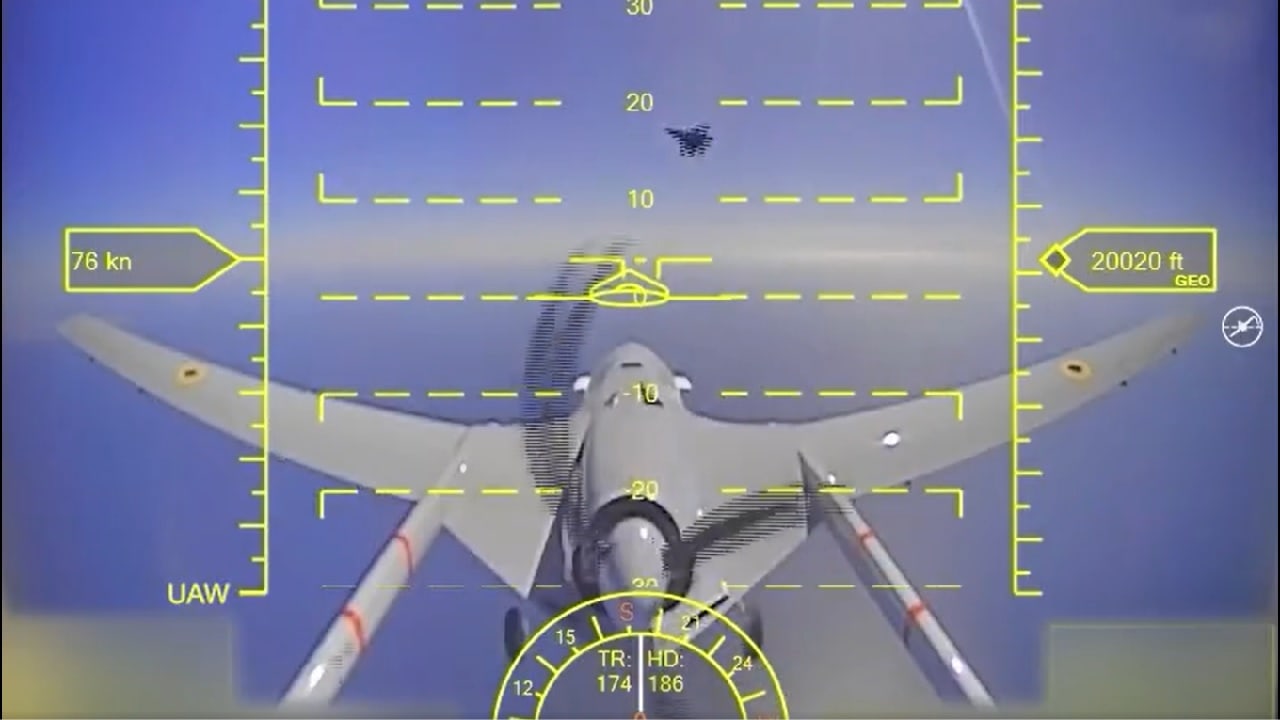Russia, it would seem, is desperate to create any drama it can when it comes to the Ukraine crisis.
Putin has lost perhaps as many as 200,000 soldiers – dead or wounded.
That means he must at least try and show strength in whatever way he can – and show it off on social media.
The ‘Jet Wash’ Crisis
A video shared by the social media account Ukraine Weapons Tracker (@UAWeapons) back in March purported to show a Russian fighter attempt to take down a Turkish-made Bayraktar TB2 unmanned aerial vehicle (UAV) over the Black Sea near the coast of Crimea.
In the more than a minute-long video, a Russian fighter – believed to be a MiG-29 – is seen flying especially close to the drone to use the “jet wash” or wake turbulence to disrupt its flight.
The efforts to bring down the TB2 UAV are believed to have been unsuccessful.
It isn’t clear when the footage was filmed, but it was shared following the March incident involving a Russian fighter that attempted a similar maneuver near a U.S. Air Force MQ-9 “Predator” drone also over the Black Sea.
After making multiple passes on the U.S. drone, the Russian fighter – one of two in that particular sortie – proceeded to dump aviation footage, and in another close pass clipped the propeller of the drone.
The collision damaged the propeller of the U.S. drone, which forced the operators to bring down the Reaper in international waters.
The Air Force also labeled the aggressive actions by Russian aircrew “dangerous,” and warned that it could lead to miscalculation and unintended escalation.
Bayraktar TB-2 in the Spotlight
The TB2 drone is among one of several UAV platforms currently employed by Kyiv’s forces. It is an armed drone that can loiter over tanks and artillery, and then launch missile strikes with deadly accuracy. The Bayraktar TB2 can reach altitudes of 25,000 feet and fly for 27 continuous hours.
Operated remotely from up to 300 km away, the Bayraktar drone is also capable of carrying four laser-guided bombs or rockets, for a total payload of some 150 kilograms.
In 2019, Turkey began selling the Bayraktar TB2 to Ukraine, which planned to equip them with the MAM-L micro-guided munitions. That round has been employed with great success in strikes against Russian tanks. Ukraine has employed a number of drones and was apparently more than ready to deploy the weapons when Russia launched its unprovoked invasion in February 2022.
Kyiv’s operators had received more than two years of training, while the UAVs became operational in the second half of 2021. They were first utilized in a reconnaissance mission over the Donbas region in late December of that year.
#Ukraine: Everyone heard about the recent MQ-9 incident- but we received a recent video that shows a Russian fighter unsuccessfully attempting to take down a much lighter Bayraktar TB-2 over the Black Sea near the coast of Crimea using jet wash in a similar manner. pic.twitter.com/YFAxqaaLz9
— ???????? Ukraine Weapons Tracker (@UAWeapons) March 19, 2023
Ukraine’s success has been good for Turkey as well; as it became a major producer and user of unmanned aerial systems (UAS), but it has also been a major weapons exporter in the process. Turkish Aerospace Industries (TAI) began developing drones in 2013 after relations between Washington and Ankara to purchase American UAVs soured.
Since the war began in Ukraine, a number of nations – including Saudi Arabia – have expressed interest in the TB2.
Russia’s Drone War in Ukraine
Drones have been seen as a potential game changer for modern warfare, and Russia has also employed unmanned aerial platforms in significant numbers.
However, Moscow has had to turn to Iran to purchase drones, including the Shahed 129, a single-engine medium-altitude long-endurance unmanned combat aerial vehicle (UCAV). It is reported to be capable of combat and reconnaissance missions and has an endurance of 24 hours.
Essentially a copy/clone of the American MQ-1 Predator, it was first unveiled in Iran’s Great Prophet 7 war games in September 2012 and entered serial production a year later.
Author Experience and Expertise:
A Senior Editor for 19FortyFive, Peter Suciu is a Michigan-based writer. He has contributed to more than four dozen magazines, newspapers, and websites with over 3,200 published pieces over a twenty-year career in journalism. He regularly writes about military hardware, firearms history, cybersecurity, politics, and international affairs. Peter is also a Contributing Writer for Forbes and Clearance Jobs. You can follow him on Twitter: @PeterSuciu.

